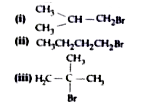Read the passage given below and answer the following questions:
Alkyl/Aryl halides may be classified as mono, di or polyhalogen compounds depending on one, two or more halogen atoms in their structures. Alkyl halides are prepared by free radical halogenation of alkanes, addition of halogen acids to alkenes and replacement of -OH group of alcohols with halogens using phosphorus halides, thionyl chloride or halogen acids. Aryl halides are prepared by electrophilic substitution to arenes.
The following questions are multiple choice questions.
Choose the most appropriate answer:
Complete the reaction:
None of the above
The correct Answer is:A
To complete the reaction of methyl bromide (CH₃Br) with silver fluoride (AgF), we will follow these steps:
Step 1: Identify the Reactants
We have two reactants:
- Methyl bromide (CH₃Br), which is an alkyl halide.
- Silver fluoride (AgF), which is a transition metal fluoride.
Step 2: Understand the Reaction Type
This reaction is known as the Swartz reaction, where an alkyl halide reacts with a transition metal fluoride. In this case, the bromine atom in methyl bromide will be replaced by a fluorine atom from silver fluoride.
Step 3: Write the Reaction
The general form of the reaction can be expressed as:
R−X+AgF→R−F+AgX
Where:
- R is the alkyl group (in this case, CH₃).
- X is the halogen (in this case, Br).
Substituting the specific reactants:
CH₃Br+AgF→CH₃F+AgBr
Step 4: Identify the Products
From the reaction, we can see that:
- The product formed is methyl fluoride (CH₃F).
- The byproduct is silver bromide (AgBr).
Final Reaction
Thus, the complete reaction is:
CH₃Br+AgF→CH₃F+AgBr
Conclusion
The correct answer to the question is that the reaction of methyl bromide with silver fluoride produces methyl fluoride and silver bromide.
---
We have two reactants:
- Methyl bromide (CH₃Br), which is an alkyl halide.
- Silver fluoride (AgF), which is a transition metal fluoride.
This reaction is known as the Swartz reaction, where an alkyl halide reacts with a transition metal fluoride. In this case, the bromine atom in methyl bromide will be replaced by a fluorine atom from silver fluoride.
The general form of the reaction can be expressed as:
R−X+AgF→R−F+AgX
Where:
- R is the alkyl group (in this case, CH₃).
- X is the halogen (in this case, Br).
CH₃Br+AgF→CH₃F+AgBr
From the reaction, we can see that:
- The product formed is methyl fluoride (CH₃F).
- The byproduct is silver bromide (AgBr).
Thus, the complete reaction is:
CH₃Br+AgF→CH₃F+AgBr
The correct answer to the question is that the reaction of methyl bromide with silver fluoride produces methyl fluoride and silver bromide.
Similar Questions
Knowledge Check
Read the passage given below and answer the following questions:
Alkyl/Aryl halides may be classified as mono, di or polyhalogen compounds depending on one, two or more halogen atoms in their structures. Alkyl halides are prepared by free radical halogenation of alkanes, addition of halogen acids to alkenes and replacement of -OH group of alcohols with halogens using phosphorus halides, thionyl chloride or halogen acids. Aryl halides are prepared by electrophilic substitution to arenes.
The following questions are multiple choice questions.
Choose the most appropriate answer:
Name the major monohalo product following reaction:
 A1-Iodo-1-methyl cyclohexaneB1-Iodomethyl cyclohexaneC1-Chloro cyclohexaneDNone of the above
A1-Iodo-1-methyl cyclohexaneB1-Iodomethyl cyclohexaneC1-Chloro cyclohexaneDNone of the aboveRead the passage given below and answer the following questions:
Alkyl/Aryl halides may be classified as mono, di or polyhalogen compounds depending on one, two or more halogen atoms in their structures. Alkyl halides are prepared by free radical halogenation of alkanes, addition of halogen acids to alkenes and replacement of -OH group of alcohols with halogens using phosphorus halides, thionyl chloride or halogen acids. Aryl halides are prepared by electrophilic substitution to arenes.
The following questions are multiple choice questions.
Choose the most appropriate answer:
Which of the following is halogen exchange reaction ?ARX+NaI→RI+NaXB CR−OH+HXZnCl2−−−→R−X+H2OD
CR−OH+HXZnCl2−−−→R−X+H2OD
Read the passage given below and answer the following questions:
Alkyl/Aryl halides may be classified as mono, di or polyhalogen compounds depending on one, two or more halogen atoms in their structures. Alkyl halides are prepared by free radical halogenation of alkanes, addition of halogen acids to alkenes and replacement of -OH group of alcohols with halogens using phosphorus halides, thionyl chloride or halogen acids. Aryl halides are prepared by electrophilic substitution to arenes.
The following questions are multiple choice questions.
Choose the most appropriate answer:
Arrange the following compounds in increasing order of their boiling points.
(i) Aii<iii<iBi<ii<iiiCiii<i<iiDiii<ii<i
Aii<iii<iBi<ii<iiiCiii<i<iiDiii<ii<i
Why alkyl halides are generally not prepared in the laboratory by free radical halogenation of alkanes?
View SolutionWhy alkyl halides are generally not prepared in the laboratory by free radical halogenation of alkanes?
View SolutionRead the passage given below and answer the following questions:
Alkyl/Aryl halides may be classified as mono, di or polyhalogen compounds depending on one, two or more halogen atoms in their structures. Alkyl halides are prepared by free radical halogenation of alkanes, addition of halogen acids to alkenes and replacement of -OH group of alcohols with halogens using phosphorus halides, thionyl chloride or halogen acids. Aryl halides are prepared by electrophilic substitution to arenes.
The following questions are multiple choice questions.
Choose the most appropriate answer:
2-Bromopentane, 2-Bromo-2-methylbutane, 1-Bromopentane.
Write the compound which is most reactive towards P-elimination reaction.
View SolutionThe alkyl halides that can be made by free radical halogenation of alkanes are :
View SolutionThe halogen atom in aryl halide is
View Solution